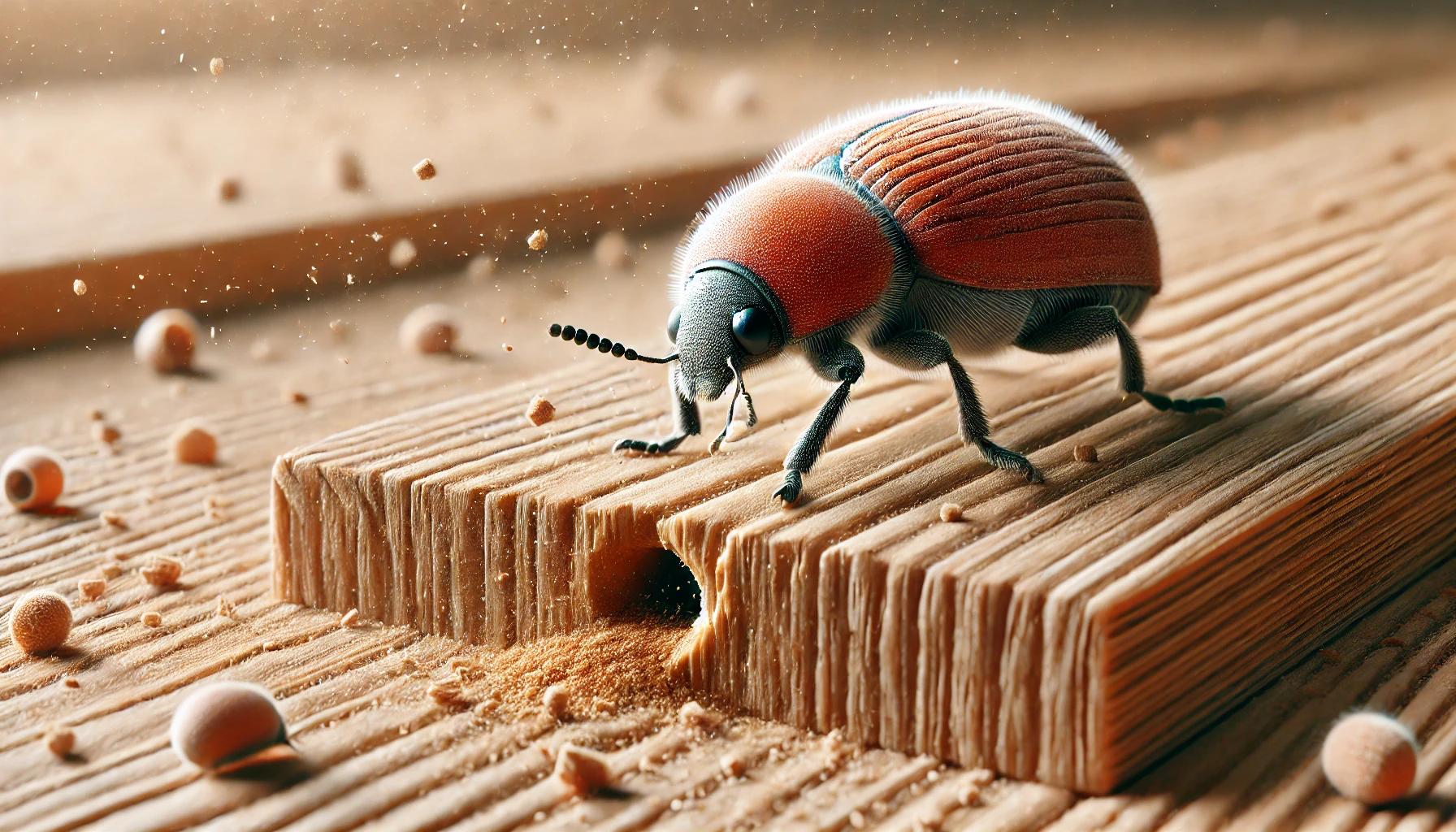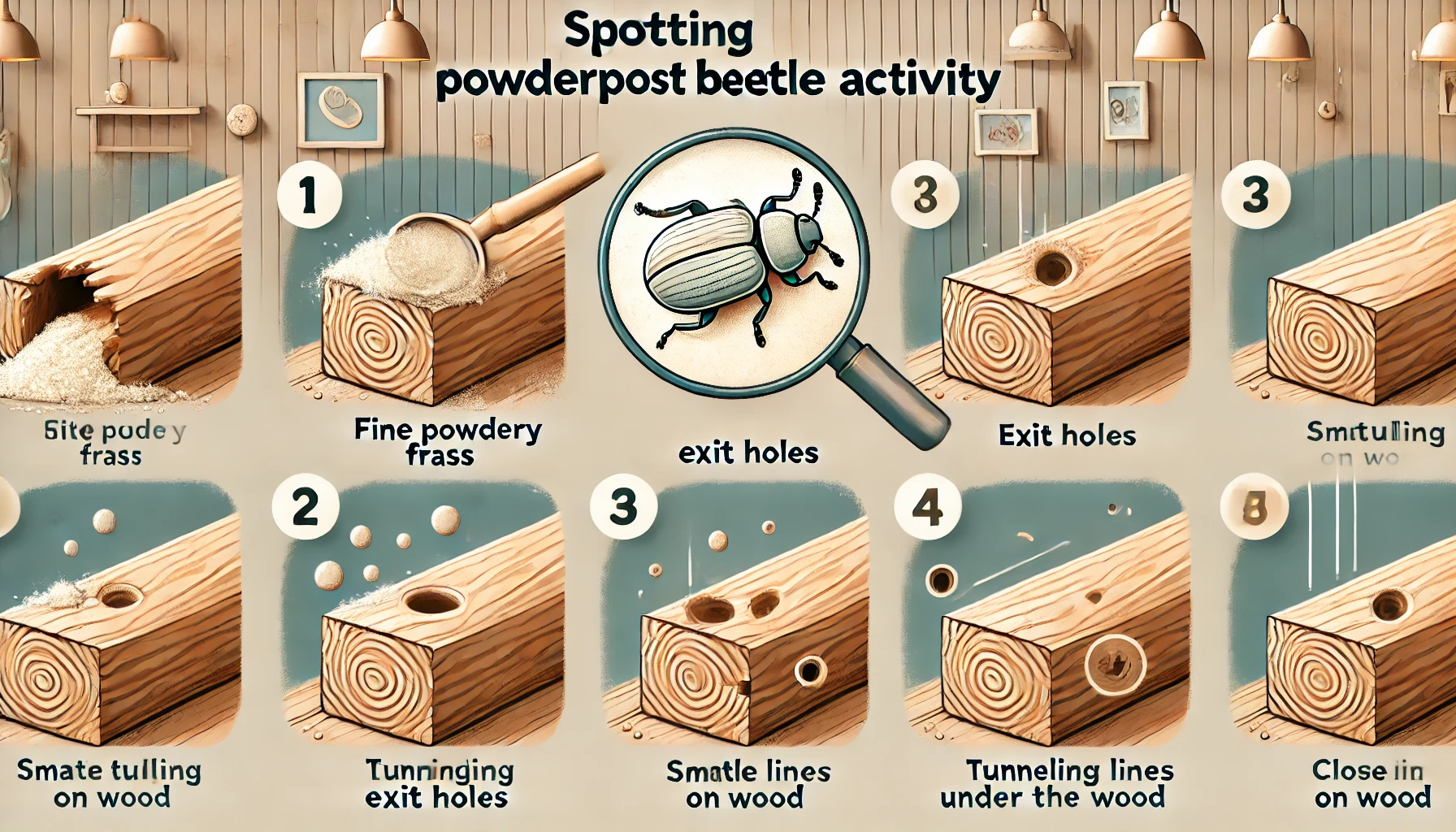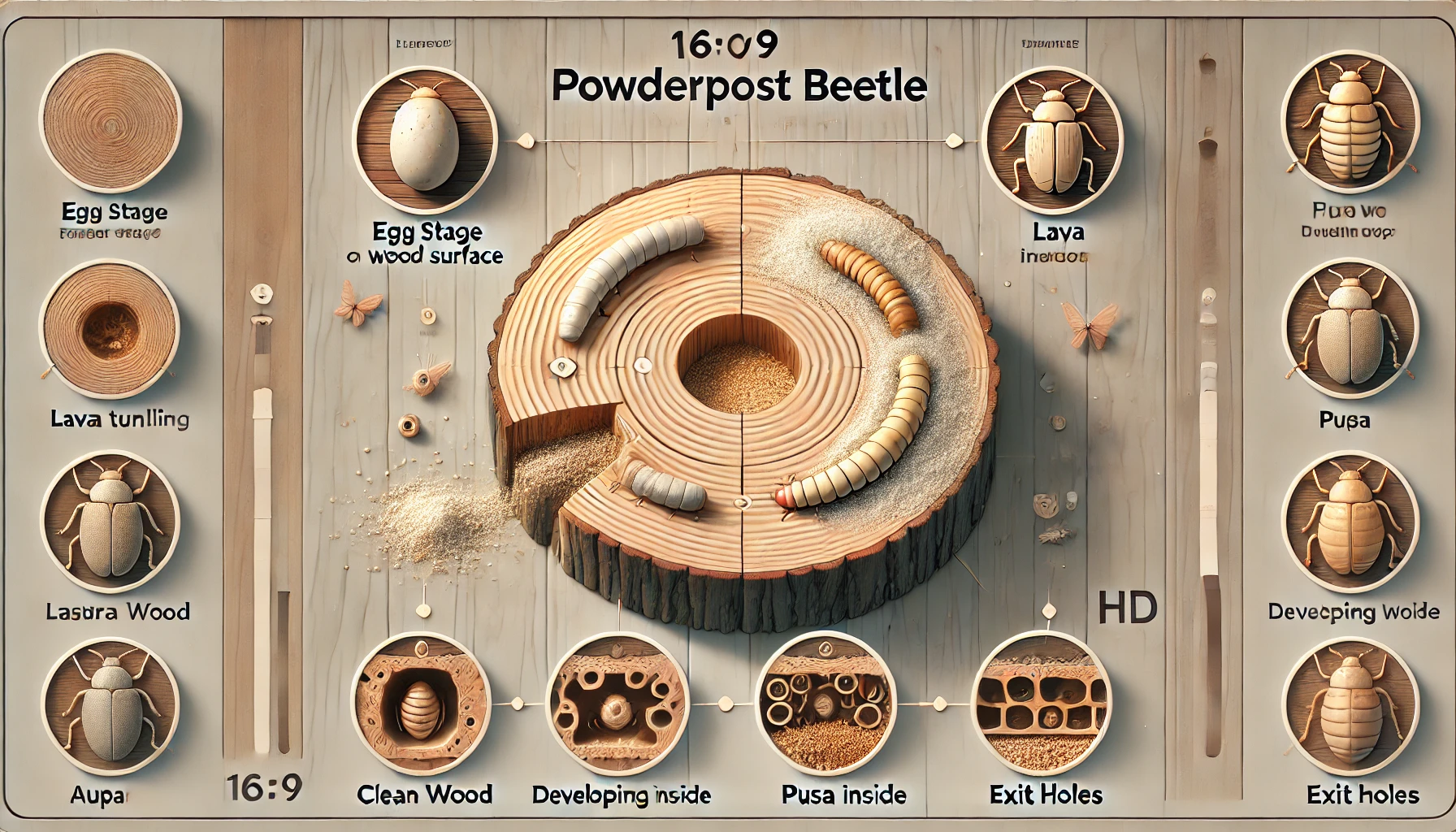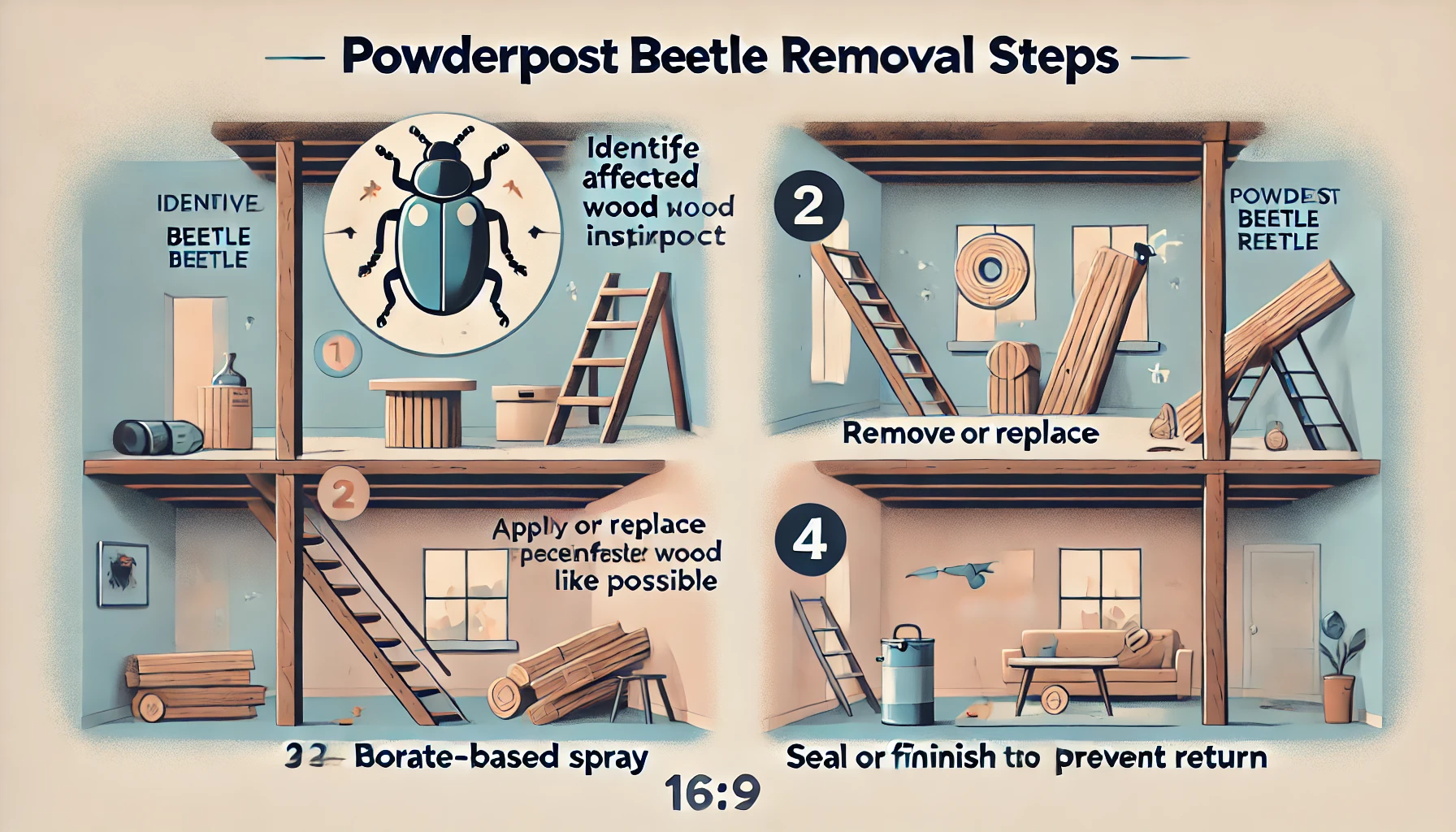Key Takeaways
- Powderpost beetles quietly damage wood, often unnoticed until significant harm is done; early detection is critical.
- Common infestation signs include tiny exit holes, fine powder (frass), weakened wood, and unusual sounds or odors.
- Controlling humidity and moisture is crucial—keeping wood dry is your first line of defense.
- Borate treatments effectively eliminate existing beetles and protect against future infestations.
- Heat or cold treatments are chemical-free alternatives for eliminating deep-set beetle larvae.
- Chemical insecticides should be applied carefully, preferably by professionals, to ensure safety and effectiveness.
- Severe infestations may require wood replacement or whole-home fumigation—costly, yet effective measures.
- Preventive strategies include inspecting new wood, using kiln-dried or treated lumber, sealing surfaces, controlling indoor humidity, and proper wood storage.
 Powderpost beetles might be small—but trust me, the damage these little pests cause can quickly spiral into big problems. Imagine your beautiful wooden furniture, flooring, or structural beams quietly crumbling away without noticing. Scary, right? Recognizing early signs and tackling the problem quickly can save you from severe headaches (and repair bills).
In this guide, we’ll help you spot powderpost beetles, understand what makes them tick, and find the best ways to get rid of these sneaky pests once and for all.
Powderpost beetles might be small—but trust me, the damage these little pests cause can quickly spiral into big problems. Imagine your beautiful wooden furniture, flooring, or structural beams quietly crumbling away without noticing. Scary, right? Recognizing early signs and tackling the problem quickly can save you from severe headaches (and repair bills).
In this guide, we’ll help you spot powderpost beetles, understand what makes them tick, and find the best ways to get rid of these sneaky pests once and for all.


Not getting a solution?
Get your free pest control estimate today!Spotting Powderpost Beetles: What’s Eating Your Wood?
You know what’s tricky about powderpost beetles? They’re often out of sight until the damage is already done. They’re tiny, wood-boring bugs mainly from three families—Lyctidae (true powderpost beetles), Anobiidae, and Bostrichidae (false powderpost beetles). They love dry, seasoned wood—the kind you have in floors, furniture, cabinets, or walls.So, How Can You Tell You’ve Got Them?
- Look out for these common signs:
-
Small, Round Exit Holes: Tiny holes about 1/16 to 1/8 inch wide are a classic sign of wood-boring beetles.
-
Fine Powdery Dust (Frass): Looks like flour or baby powder—found beneath or near infested wooden furniture.
-
Weak or Crumbly Wood: Furniture or structures may feel fragile or unstable due to internal damage.
-
Adult Beetles Wandering: Seeing beetles around wooden surfaces suggests an active infestation.
-
Clicking or Tapping Sounds: Subtle sounds from inside wood may mean larvae are chewing their way through.
-
Unusual Musty Odours: A subtle musty smell, especially in enclosed areas, can signal infestation.
-
Paint or Varnish Blistering: Surface finishes may bubble as larvae move beneath the wood.

Understanding Their Sneaky Life Cycle
Here’s the thing—powderpost beetles are sneaky. They lay eggs on wood surfaces, and once these eggs hatch, the larvae quietly tunnel into the wood, munching away unnoticed for months or even years. Significant damage has likely occurred by the time adult beetles emerge, leaving behind tiny holes and dust. So, catching an infestation early can save you tons of stress. The larvae can take their sweet time, staying hidden and comfortable inside wood until conditions are just right for them to emerge as adults, making timely detection crucial. Honestly, it’s like having tiny hidden time bombs in your woodwork!
How to Kick Powderpost Beetles Out of Your Home
Now, if you’re dealing with these beetles, don’t panic. Honestly, you’ve got several good options to reclaim your wood. Keep It Dry (Really Dry) Beetles adore damp conditions—so don’t give them what they love!- Set up dehumidifiers or fans in damp areas like basements, attics, garages, or bathrooms.
- Fix plumbing leaks quickly and boost ventilation—fresh air is your friend here.
- Aim to keep wood moisture below 15-20%.
- Brush or spray borate directly onto untreated surfaces.
- Got thick wood? Drill small holes to let the solution seep in deeply.
- Always read the instructions—safety first!
- Heat-affected wood items above 130°F for several hours—beetles won’t survive.
- Smaller items? Pop them in a freezer at 0°F for several weeks. Beetles hate the cold too!
Chemical Solutions: Hitting Beetles Where They Hide
Insecticides can effectively reach larvae hiding inside finished wood:- Inject insecticidal foam or dust directly into holes.
- Professional application helps make sure every little hiding spot is covered safely.
When It’s Bad: Wood Replacement or Fumigation
Sometimes the infestation is just too severe. You know what? It’s okay to replace damaged wood entirely:- Remove and replace heavily infested timber to eliminate the problem’s source.
- Whole-home fumigation by licensed experts is a last resort but can eliminate widespread issues effectively.

Stopping Powderpost Beetles Before They Start
Honestly, prevention is your best defense. Keep these pests out of your home by following these simple steps: Check New Wood Carefully Always inspect new lumber or reclaimed wood closely before it enters your home. Look for signs of beetles and apply borate treatments ahead of time. Better safe than sorry! Choose Kiln-Dried or Treated Wood Kiln-dried or chemically treated wood is less attractive to beetles because treatments kill existing pests and eggs. Make this your go-to for renovations or repairs. Seal Those Wood Surfaces Paint, varnish, or seal all wooden surfaces. Sealed wood means no easy place for beetles to lay their eggs. Regular upkeep, especially in damp spots, keeps protection strong and your home looking great. Keep Humidity Under Control Maintain indoor humidity between 30% and 50%. Use dehumidifiers and proper ventilation to make your home unfriendly to beetles. Store Wood Wisely Store firewood and unused lumber outdoors, raised off the ground, and away from your home. If you must store it inside, ensure it stays dry and inspect regularly. By following these proactive steps, you can sleep easy knowing your home is protected from the sneaky powderpost beetle invasion. After all, your home should be a sanctuary—not a snack for hidden pests!If you feel things have gone out of control, it is advised to contact pest control professionals. Our team can provide a customized approach to protect your home effectively.
Visit our Species, Control, and DIY Guide sections for additional resources on beetle and ways to tackle a beetle infestation.





